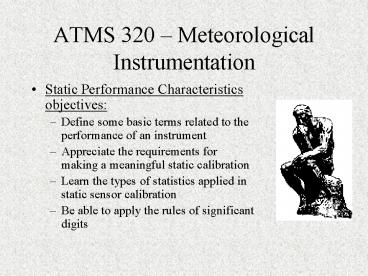Static Performance Characteristics objectives: - PowerPoint PPT Presentation
1 / 24
Title:
Static Performance Characteristics objectives:
Description:
ATMS 320 Meteorological Instrumentation Static Performance Characteristics objectives: Define some basic terms related to the performance of an instrument – PowerPoint PPT presentation
Number of Views:112
Avg rating:3.0/5.0
Title: Static Performance Characteristics objectives:
1
ATMS 320 Meteorological Instrumentation
- Static Performance Characteristics objectives
- Define some basic terms related to the
performance of an instrument - Appreciate the requirements for making a
meaningful static calibration - Learn the types of statistics applied in static
sensor calibration - Be able to apply the rules of significant digits
2
ATMS 320 Static Performance Characteristics
- Sensor performance characteristics
- Static
- Dynamic
- Drift
- Exposure
http//www.ticketmaster.com/artist/804226/
3
ATMS 320 Static Performance Characteristics
- Sensor performance characteristics
- Static
- Dynamic
- Drift
- Exposure
http//www.playbill.com/index.php
4
ATMS 320 Static Performance Characteristics
- See formal definition of terms, Analog signal
Transducer in Section 3.1 of the text
Instrument An instrument is a sensor plus other
transducers as required, and a data display
element.
Sensor An element that receives energy from the
measurand and produces an output signal related
in some way to the measurand.
Transducer A device that converts energy from
one form to another.
5
ATMS 320 Static Performance Characteristics
- Static calibration
- Performed by varying one input, usually in a
stepwise fashion, over the possible range of
values while holding other inputs, if any,
constant.
http//www.otis.com/products/listing/0,1357,CLI1_P
RT44_RES1,00.html
Ultimate objective of calibration to define
instrument accuracy.
6
ATMS 320 Static Performance Characteristics
- Static calibration example
- At each measurement step, the output is observed
in steady-state conditions (when the input has
been held steady long enough for the output to
stabilize).
one period of calibration
7
ATMS 320 Static Performance Characteristics
- Transfer plot a plot of sensor raw output
versus the measurand over the design range of the
sensor.
8
ATMS 320 Static Performance Characteristics
- Range measurand interval over which a sensor is
designed to respond
range
9
ATMS 320 Static Performance Characteristics
- Span algebraic difference between the upper and
lower range values
? span
100 0 100
10
ATMS 320 Static Performance Characteristics
- Static sensitivity slope of the transfer curve.
Example
static sensitivity
d raw output / d input
11
ATMS 320 Static Performance Characteristics
- Input/output fit
- Linear v. non-linear
- Random error
- Cannot be individually eliminated because the
errors are not predictable ? causes uncertainty
in the measurement
Random error non-systematic error that can only
be described statistically and cannot be
corrected.
12
ATMS 320 Static Performance Characteristics
- Hysteresis when the sensor output for a given
input depends upon whether the input was
increasing or decreasing - Threshold special case of hysteresis that
occurs when the output remains zero while the
input slowly increases.
See Section 3.2 for other definitions resolution,
linearity, stability,
13
ATMS 320 Static Performance Characteristics
- Cookbook for calibration (how to derive the
calibration equation)
Note
because of random errors
http//www.marthastewart.com/
14
ATMS 320 Static Performance Characteristics
Xi is the measurand (primary input) a is a
coefficient of the statistical fit
In order to be able to determine the coefficients
of the calibration equation, there must be at
least N measurements of input/output to match
the N coefficients (number of equations number
of unknowns).
Most likely, we will have more data pairs
(input/output) than number of coefficients that
we desire for our equation, so we use
15
ATMS 320 Static Performance Characteristics
The Method of Least-Squares (Section 3.2.2)
Let us use the chalkboard to show an example
(Section 3.3)
16
ATMS 320 Static Performance Characteristics
The Method of Least-Squares notes from
chalkboard
17
ATMS 320 Static Performance Characteristics
The Method of Least-Squares notes from
chalkboard
18
ATMS 320 Static Performance Characteristics
is the raw sensor output (w/ error) c is a
coefficient of the calibration eqtn. X1 is the
best estimate of the true but unknowable
input (subscript 1 refers to the sensor
output as designated in Fig. 1-1 of the
textbook).
19
ATMS 320 Static Performance Characteristics
Actual measurand amount
Instrument error
Best estimate of measurand (from calibration
eqtn.)
20
ATMS 320 Static Performance Characteristics
Gaussian distribution
standard deviation
mean
bias, imprecision, inaccuracy definitions are
found in Section 3.2.2.1 of the textbook
21
ATMS 320 Static Performance Characteristics
The purpose of static calibration is to remove
the bias and to numerically define the
imprecision.
Problems -drift since last calibration -secondary
inputs not accounted for in calibration
e.g. aneroid barometer is sensitive to
changes in air temperature
22
ATMS 320 Static Performance Characteristics
- Examples of sensors with bias and imprecision
- Bias 0, imprecision is large
- Bias large, imprecision small
- Bias 0, small imprecision
input
(input is the constant value shown)
23
ATMS 320 Static Performance Characteristics
- In the previous examples, we have treated
instrument error as if it originated from a
single source - In reality there are multiple sources of error
If each error is independent of the other
then the errors can be combined using
the root-sum-square (RSS)
24
ATMS 320 Static Performance Characteristics
- Rules for applying significant digits
- Nonzero digits are significant
- Zeros between nonzero digits are significant
- Zeros to the left of the first nonzero digit in a
number are not significant - Zeros to the right of the decimal point are
significant - Some ambiguity when a number ends in zeros that
are not to the right of the decimal point
http//www.nlm.nih.gov/medlineplus/ency/imagepages
/19665.htm
Computer precision is not related to instrument
precision (shameless advertisement for course
next semester ATMS 261)






























